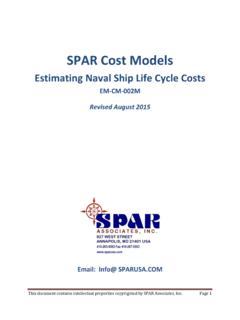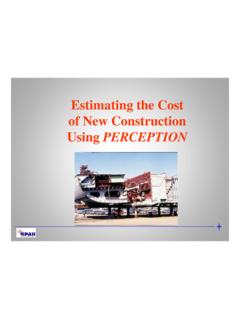Transcription of Integrating Cost Estimating with the Ship Design …
1 Laurent Deschamps and Charles Greenwell, SPAR Associates, Inc. Integrating cost Estimating with the ship Design Process ABSTRACT The ship Design process is an evolutionary process where at the conceptual Design level, pre Milestone A for naval acquisition programs, few details are know and the metrics used for Estimating costs are based on analogous platforms and limited parametric functions. As the Design process continues towards Milestone B the Design begins to take shape with fewer analogies and an increasing number of parametric cost drivers.
2 At this point, 80% of the life cycle costs (LCC) are set and the cost risk associated with the Design becomes an important piece of the overall acquisition costs. It is imperative that the methods used to estimate the cost and cost risk are tightly coupled with the Design iteration process and are parametric in nature in order to support the needs of the Program Manager in terms of not only the basic Design but Design trade-offs. The authors present the use and benefits of employing a set of parametric cost models during the concept and preliminary phases of ship Design .
3 These cost models produce quick assessments of costs and risk, for Design and mission trade-off alternatives. The cost models, being parametric, can follow the evolutionary Design process. At early stages of the Design , when many details of the Design are not yet available, the cost models automatically provide statistically-synthesized values for missing parameters. Then, as the Design matures, these default values can be replaced with values developed for the Design . INTRODUCTION The cost models provide a range of structural, powering and manning selections to predict weights, costs and various performance characteristics.
4 The cost models substitute default ship Design parameters, developed from statistical data analyses, until actual Design data can be determined. In this way, the cost estimate can follow the Design evolution and can quickly produce cost changes due to Design trade off alternatives. Since the models are parametric, this allows many different Design variables to be modified and the impact of these changes measured directly for cost and cost risk. Similar parameters apply to life cycle elements including the impact of crew, fuel price, and speed. Separate baseline models are used for different hull types (Mono-Hulls, Catamarans and Trimarans).
5 In addition, the baseline models have been extended to focus on particular ship types: for example, various high speed vessels, tankers, bulk carriers, container ships, patrol boats, cutters, frigates, hydro-graphics vessels, RO-CON-PAX ships, etc. These cost models have been successfully used to estimate costs across a wide range of projects both military and commercial. The following are only a selection of projects where the cost models have been used. Navy Heavy Air Lift Seabasing ship (HALSS): CCDoT cost estimates & risk assessments for building large trimaran under two different Design & build strategies (traditional & virtual shipbuilding).
6 Short Sea Shipping Trailership (SSST): CCDoT cost estimates for concept trimaran Design for commercial and military modes, including preliminary returns on investment estimates. American Marine Highways High Speed Trimaran Dual-Use TrailerShip: CCDoT Design , construction and life cycle cost estimates to estimate cost of naval defense features and commercial return on investment (ROI). Navy High Speed Sealift Navy Vision Trimaran (HSS): NSWCCD cost estimates for high speed composite sealift concept ship . cost estimates for commercial SWATH & SLICE ferries & crew/supply boats Navy Joint High Speed Vessel (JHSV) Concept Trimaran: cost estimates for baseline Design plus three military variants.
7 Navy Joint High Speed Vessel (JHSV) Concept Catamaran: cost estimates for baseline Design plus two military variants. USCG FRP-B Fast Response Patrol Boat (Steel, Aluminum & Composite Variants) with alternate build strategies USCG NSC National Security Cutter for five alternate build strategies Foreign-built naval Hydrographic/Anti-Mine Warfare ship : cost estimates for three (3) size ships built under two different Design & build strategies. Foreign-built frigate cost estimates cost estimate for concept naval corvette: Estimating cost and schedule savings potential from advanced Design and construction methods with modularized equipment and outfit components.
8 HOW THE cost MODELS WORK The following describes the general characteristics of how the cost models work. Parametric cost Data The cost models are parametric and offer a wide range of options: dimensional; cargo carrying capacity; propulsion systems; crew and passenger size; structural materials, systems and equipment. The cost Estimating Relationships (CERs) represent a wide cross-section of current and historical shipyard construction costs at many levels of detail. They reflect how ships are built. The CERs primarily are not weight-based, but based on many different metrics: for example, crew size, power kW, compartment volume, etc.
9 , etc. These CERs were developed from a comprehensive data library residing on SPAR s Estimating system called PERCEPTION ESTI-MATE. These CERs, while parametric in nature, focus on a specific area of cost : systems, subsystems, components and modules. Each reflects the specific material and the manufacturing and assembly processes required. The CERs used in the cost models are based on average costs that are expected from a mid-sized commercial shipbuilder. These CERs are referred to as the generic CERS. In order to compile generic CERs for the cost models, adjustments have been made for different shipyard productivities, manufacturing and construction methods and material costs.
10 The cost models provide features for applying various productivity factors to these CERs to accommodate average cost differences between commercial and military shipbuilding business practices as well as for other non-generic considerations discussed below. The cost model s approach for an estimate is based first upon the composition of the hull s structural components (decks, bulkheads, shell, double bottoms, superstructure, etc.). Each block type carries a different CER, mostly for labor, since each requires a different set of manufacturing, assembly and erection processes; therefore each type has its own cost on a per ton basis.



